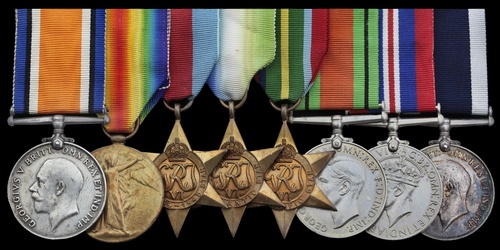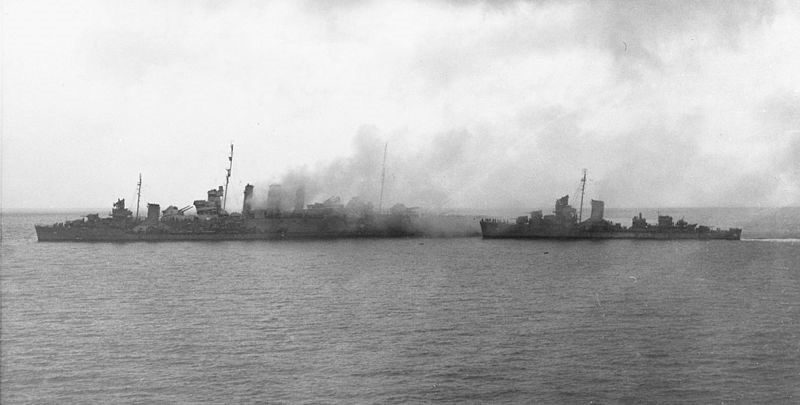Auction: 22002 - Orders, Decorations and Medals
Lot: 87
A Great War and Second World War campaign group of eight awarded to Able Seaman C. J. Le Fevre, Royal Navy, attached Royal Australian Navy 1942-43
His wartime sojourn with the Australians proved to be of the action-packed variety, for he was present aboard H.M.A.S. Canberra at the battle of Savo Island in August 1942: a victim of sustained and accurate fire from Japanese cruisers, Canberra suffered a loss of 84 killed and over 100 wounded, and had to be abandoned
Removing to H.M.A.S. Adelaide, Le Fevre was next in action in November 1942, when he and his shipmates had a convincing encounter with the German blockade runner Ramses: the latter was dispatched by Adelaide's guns in just eight minutes
Yet Le Fevre was no stranger to close encounters with the enemy, having shared in the destroyer H.M.S. Malcolm's notable part in Operation "Dynamo": often a target of the Luftwaffe, she somehow survived no less than eight trips to Dunkirk and brought away a total of 6,400 troops
British War and Victory Medals (J. 93412 C. J. Le Fevre, Boy 2, R.N.); 1939-45 Star; Atlantic Star; Pacific Star; Defence and War Medals 1939-45; Royal Navy L.S. & G.C., G.V.R., 3rd issue (J. 93412 C. J. Le Fevre, A.B., H.M.S. Tern), the Great War pair polished, thus fine, the reminder very fine or better (8)
Charles Joseph Le Fevre was born in West Ham, London on 27 July 1903 and entered the Royal Navy as a Boy 2nd Class in November 1918. His first seagoing appointment was in H.M.S. Royal Sovereign from August 1919 to January 1921, in which period she was deployed to the troubled waters of Eastern Mediterranean and evacuated White Russians from Constantinople, among them a princess of the Galitzine family.
"Dynamo"
Awarded his L.S. & G.C. Medal in August 1936, Le Fevre joined the destroyer Malcom on the renewal of hostilities in September 1939, in which capacity he first saw action in Operation "Ordnance" off the Hook of Holland in May 1940.
But it was for her outstanding work in Operation "Dynamo" during the period 28 May - 4 June 1940 that the Malcolm won high praise: she undertook no less than eight trips to the beaches and Dunkirk pier, bringing away a total of 6,400 troops. Under incessant attack throughout these gallant forays, Malcolm was much battered by near misses but the behaviour of her ship's company was excellent throughout.
Full details of her part in "Dynamo" are recounted in the pages of Divine's Dunkirk and Walter Lord's The Miracle of Dunkirk. One of Malcolm's most noteworthy exploits was the rescue of soldiers embarked on the Clan MacAllister on 29 May, when she fought off countless attacks by Ju. 88s while passing over fire hoses to help fight the flames on the stricken merchantman - her hold laden with 4-inch ammunition. Malcolm's time off the beaches at La Panne was particularly harrowing, the ship's 'Jimmy the One' having to draw his revolver and threaten the next man who tried to rush the ship's boat. On a lighter note, another of Malcolm's officers played the bagpipes on the ship's foc'sle as some Cameron Highlanders were embarked.
Her final trip was made on the night of the 3-4 June to embark part of the French rear-guard which had been holding the Dunkirk perimeter. This was the occasion that her officers sallied forth wearing their bow ties and monkey jackets, for they had intended to celebrate Malcolm's return from her seventh trip. In the event, Admiral Ramsay called upon her exhausted crew to undertake one further mission. Walter Lord's The Miracle of Dunkirk, takes up the story:
'On the destroyer Malcolm the morning had begun on a high note. She was just back from her seventh trip to Dunkirk and was still in one piece. The last of the B.E.F. had been evacuated and everyone assumed that the operation was over. Breakfast in the wardroom was a merry affair.
Lieutenant Mellis fell on his bunk hoping to catch up on his sleep. He was so tired he didn't even take his clothes off. Several hours later he was awakened by the sound of men's feet on the deck overhead. He learned that the crew was assembling for an important announcement by Captain Halsey, who had just returned from Ramsay's headquarters. Halsey came quickly to the point: "The last of the B.E.F. was able to come off because the French took over the perimeter last night. Now the French have asked us to take them off. We can't do anything else, can we?"
No. But it was still a shock. For Mellis, it was the worst moment of the whole show. To enjoy that delicious feeling of relief and relaxation - and then to have it all snatched away - was almost more than he could stand. The wardroom had planned a festive evening, and decided to dress festively anyhow. When Malcolm sailed on her eighth trip to Dunkirk at 9.08 p.m. on 3 June, her officers were wearing their bow ties and monkey jackets … '
Captain T. E. Halsey, R.N., Malcolm's skipper, was awarded the D.S.O., one of his officers the D.S.C. and eight ratings the D.S.M.; 12 of her complement were mentioned in despatches.
For an eye-witness account of Malcolm's part in "Dynamo", as related by one her ratings, see:
https://www.bbc.co.uk/archive/dunkirk-a-personal-perspective--hms-malcolm/zh4m92p
Royal Australian Navy
In May 1942, Le Fevre was loaned to the Royal Australian Navy, the same month in which he joined the heavy cruiser H.M.A.S. Canberra. And he was likewise employed at the time of her loss at the battle of Savo Island on 9 October 1942.
On that occasion, Canberra was serving in support of the Guadalcanal landings, as part of a task force under Rear-Admiral Victor Crutchley, V.C., D.S.C. In the early morning hours of 9 August, the force was split around Savo Island when surprised and intercepted by a Japanese task group under Vice-Admiral Gunichi Mikawa. Canberra, lit-up by enemy flares, was quickly on the receiving end of incoming fire from Mikawa's cruisers.
The first two salvoes severely damaged the bridge, killing or wounding several senior officers, and a further 22 hits were registered in the opening minutes of the engagement. Immobilised - both of her engine rooms were disabled - Canberra listed to port, with multiple internal fires and heavy casualties: of her complement of 819 officers and ratings, 74 were killed outright and over 100 wounded, 10 of whom would subsequently die from their wounds.
In consequence, it was decided that Canberra would have to be abandoned and scuttled, her surviving crew and the wounded being taken off by destroyers of the United States Navy. Yet Canberra proved to be a hard nut to crack, a torpedo strike and 263 5-inch shells delivered by the U.S.S. Selfridge failing to sink her. Finally, at 0800 hours, the U.S.S. Ellet accomplished the task with another torpedo strike.
Subsequent wartime career
Following the Canberra's loss, and a stint ashore at Brisbane's naval base, Le Fevre served in the cruiser Adelaide from October 1942 to July 1943.
It proved to be another memorable chapter in his wartime career for, in late November 1942, whilst patrolling in the Indian Ocean, Adelaide encountered the German blockade runner Ramses. The enemy ship was pretending to be a Norwegian merchantman, but her disguise was recognised, and Adelaide's guns were quickly on target. Under a torrent of accurate fire, the enemy ship was dispatched in just eight minutes.
Le Fevre came ashore to Lonsdale at Melbourne in July 1943, followed by a stint of service at Penguin, the Sydney naval establishment, and he was returned to the Royal Navy in October 1943.
His service record further confirms that he was invalided ashore in July 1944.
Subject to 20% VAT on Buyer’s Premium. For more information please view Terms and Conditions for Buyers.
Sold for
£1,100
Starting price
£140







